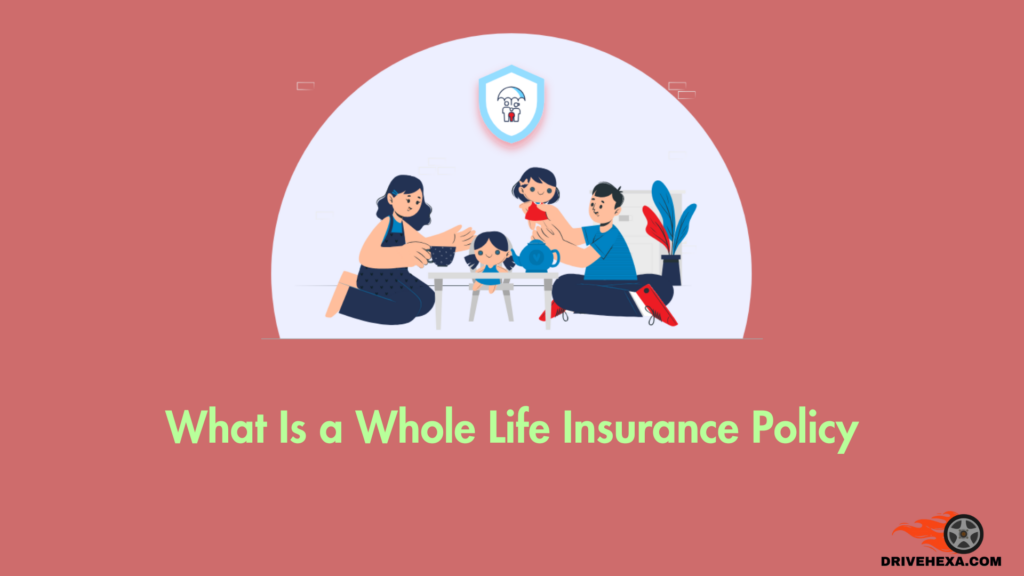When it comes to securing your financial future, one of the most critical decisions you’ll make is choosing the right life insurance policy. You may have heard about whole life insurance and wondered if it’s the right choice for you. But what exactly is a whole life insurance policy, and why should you consider it? Let’s dive into the details.

Contents
What Is a Whole Life Insurance Policy?
A whole life insurance policy is a type of permanent life insurance. Unlike term life insurance, which only covers you for a specific period (like 10, 20, or 30 years), whole life insurance provides coverage for your entire life—as long as you keep paying the premiums.
This type of policy not only offers a death benefit (the amount your beneficiaries receive when you pass away) but also includes a cash value component. The cash value is a savings element that grows over time, tax-deferred, and can be used during your lifetime for various purposes.
How Does Whole Life Insurance Work?
When you purchase a whole life insurance policy, you’re entering into a contract with the insurance company. You agree to pay premiums—either monthly or annually—and in return, the company guarantees to pay a death benefit to your beneficiaries upon your passing.
But there’s more to it. Part of the premium you pay goes toward the cost of insurance (the death benefit), while the other part goes into the cash value account. Over time, the cash value grows at a guaranteed rate, and depending on the policy, you might also earn dividends from the insurance company.
What Are the Key Features of a Whole Life Insurance Policy?
Whole life insurance comes with several key features that make it unique:
- Permanent Coverage: You’re covered for life, as long as premiums are paid.
- Fixed Premiums: The premiums remain the same throughout the life of the policy, providing predictability.
- Guaranteed Death Benefit: Your beneficiaries will receive a fixed death benefit when you pass away.
- Cash Value Accumulation: A portion of your premium builds cash value, which grows tax-deferred.
- Dividend Payments: Some policies may pay dividends, which can be used to reduce premiums, increase the death benefit, or be taken as cash.
Why Should You Consider Whole Life Insurance?
Now that you know what whole life insurance is, the next question is: Why should you consider it? Whole life insurance can be a valuable tool in your financial arsenal for several reasons.
Is Whole Life Insurance a Good Investment?
Whole life insurance is often debated as an investment vehicle. While it’s not a traditional investment like stocks or bonds, it does offer a unique combination of insurance protection and savings growth.
The cash value component of whole life insurance grows over time, and it’s tax-deferred, meaning you don’t pay taxes on the growth until you withdraw it. Additionally, the policy’s cash value can be borrowed against or even withdrawn in retirement, providing you with a source of funds when you need it.
However, it’s essential to understand that whole life insurance isn’t typically considered a high-return investment. Its primary purpose is to provide lifelong coverage, with the added benefit of cash value accumulation. If you’re looking for a product that offers both insurance protection and a conservative way to grow your savings, whole life insurance might be worth considering.
How Does Whole Life Insurance Help with Estate Planning?
One of the most significant advantages of whole life insurance is its role in estate planning. If you have substantial assets and are concerned about estate taxes, a whole life insurance policy can be an effective way to provide liquidity to your estate. The death benefit can be used to cover estate taxes, ensuring that your heirs receive the full value of your estate.
Additionally, the death benefit from a whole life insurance policy is generally tax-free, providing your beneficiaries with a financial cushion during a difficult time. It can also help cover final expenses, such as funeral costs, so your loved ones don’t have to bear that burden.
Can Whole Life Insurance Be Used for Retirement Planning?
Yes, whole life insurance can be a valuable part of your retirement planning strategy. The cash value component of the policy can be accessed during your retirement years, either through withdrawals or loans. This can provide you with an additional source of income in retirement, especially if your other retirement accounts are running low.
Moreover, because the cash value grows tax-deferred, you can enjoy the growth without worrying about immediate tax implications. And if you borrow against the policy, the loan is not considered taxable income.
How Does Whole Life Insurance Compare to Other Life Insurance Options?
When deciding whether to buy whole life insurance, it’s essential to compare it to other life insurance options, like term life insurance and universal life insurance.
Term Life Insurance vs. Whole Life Insurance:
- Term Life Insurance: Offers coverage for a specific period, usually at a lower cost, but with no cash value accumulation.
- Whole Life Insurance: Provides lifelong coverage, with the added benefit of cash value growth and fixed premiums.
Universal Life Insurance vs. Whole Life Insurance:
- Universal Life Insurance: Offers flexible premiums and death benefits, with the potential for higher cash value growth but at a higher risk.
- Whole Life Insurance: Provides more predictability with fixed premiums and guaranteed cash value growth.
What Are the Costs Associated with Whole Life Insurance?
It’s no secret that whole life insurance is more expensive than term life insurance. But what exactly are the costs involved, and how do they impact your financial planning?
How Are Premiums Determined?
The premiums for whole life insurance are determined based on several factors, including your age, health, the amount of coverage you want, and the type of policy you choose. Because whole life insurance provides lifelong coverage and builds cash value, the premiums are higher than those for term life insurance.
However, the premiums are fixed for the life of the policy, meaning they won’t increase as you age or if your health declines. This can be a significant advantage, as it provides predictability in your financial planning.
What Is the Cash Value of a Whole Life Insurance Policy?
The cash value is a critical component of a whole life insurance policy. It’s the portion of your premium that accumulates over time and can be accessed during your lifetime.
The cash value grows at a guaranteed rate, and depending on your policy, you might also receive dividends that can increase the cash value. Over time, this cash value can become a substantial asset that you can use for various purposes, such as borrowing against it or even withdrawing it in retirement.
Can You Borrow Against Your Whole Life Insurance Policy?
Yes, one of the unique features of whole life insurance is that you can borrow against the cash value of your policy. This can be a convenient way to access funds without going through a traditional loan process.
When you borrow against your policy, the loan is taken from the cash value, and the interest rate is typically lower than that of other types of loans. However, it’s essential to understand that if you don’t repay the loan, it will reduce the death benefit, meaning your beneficiaries will receive less.
How Do You Choose the Right Whole Life Insurance Policy?
Choosing the right whole life insurance policy is a significant decision that requires careful consideration of your financial goals, needs, and budget. So, how do you go about making this choice?
What Should You Look for in a Whole Life Insurance Policy?
When evaluating whole life insurance policies, consider the following factors:
- Company Reputation: Choose an insurance company with a strong financial rating and a good reputation for paying claims.
- Policy Features: Look for policies that offer guaranteed cash value growth, the potential for dividends, and flexible options for accessing the cash value.
- Cost: Ensure that the premiums fit within your budget and that you’re comfortable with the long-term financial commitment.
- Customization Options: Some policies offer riders or additional benefits that can be added to the policy, such as a long-term care rider or a waiver of premium rider.
How Do You Compare Whole Life Insurance Policies?
Comparing whole life insurance policies can be challenging, given the complexity of the product. Here’s a simple table to help you compare some of the key features:
| Company Reputation | A+ Rated | A Rated | A+ Rated |
| Premiums | $300/month | $250/month | $350/month |
| Cash Value Growth Rate | 4% Guaranteed | 3.5% Guaranteed | 4.5% Guaranteed |
| Dividend Potential | Yes | No | Yes |
| Additional Riders | Long-Term Care, Waiver of Premium | Waiver of Premium | Long-Term Care, Disability Waiver |
Should You Work with a Financial Advisor?
Given the complexity of whole life insurance, it may be beneficial to work with a financial advisor who can help you navigate the options and choose the policy that best fits your needs. A financial advisor can provide you with personalized advice and help you understand how a whole life insurance policy fits into your overall financial plan.
What Are the Potential Drawbacks of Whole Life Insurance?
While whole life insurance offers many benefits, it’s not without its drawbacks. Understanding these potential downsides is essential in making an informed decision.
Is Whole Life Insurance Worth the Cost?
One of the most significant drawbacks of whole life insurance is its cost. The premiums for whole life insurance are substantially higher than those for term life insurance, which can strain your budget.
If your primary goal is to provide financial protection for your loved ones at an affordable cost, term life insurance might be a better option. However, if you’re looking for lifelong coverage with the added benefit of cash value accumulation, whole life insurance may be worth the higher cost.
Can the Cash Value Component
Be Limiting?
While the cash value component of a whole life insurance policy can be an asset, it’s not as flexible or high-yielding as other investment options. The cash value grows at a guaranteed rate, but this rate is typically lower than what you might achieve with other investments like stocks or mutual funds.
Additionally, accessing the cash value through loans or withdrawals can reduce the death benefit, which may not be desirable if your primary goal is to provide financial protection for your beneficiaries.
What Happens If You Stop Paying Premiums?
If you stop paying premiums on a whole life insurance policy, the policy could lapse, meaning you’ll lose both the death benefit and the cash value. However, many policies offer options to prevent this from happening.
For example, you might be able to use the cash value to pay the premiums or reduce the death benefit to lower the premium costs. It’s essential to understand these options and work with your insurance company to avoid lapsing the policy.
Is Whole Life Insurance Right for You?
After considering all the features, benefits, and potential drawbacks, you might be wondering: Is whole life insurance right for me? The answer depends on your individual financial goals, needs, and circumstances.
When Is Whole Life Insurance a Good Fit?
Whole life insurance can be a good fit if:
- You Want Lifelong Coverage: If you want to ensure that your loved ones are protected no matter when you pass away, whole life insurance provides that peace of mind.
- You’re Interested in Building Cash Value: If you’re looking for a way to grow savings on a tax-deferred basis while also having life insurance coverage, whole life insurance offers that dual benefit.
- You’re Planning for Estate Taxes: If you’re concerned about estate taxes and want to provide liquidity to your estate, the death benefit from a whole life insurance policy can be a valuable tool.
When Might Whole Life Insurance Not Be the Best Choice?
On the other hand, whole life insurance might not be the best choice if:
- You’re Looking for Affordable Coverage: If your primary goal is to provide financial protection for your loved ones at the lowest possible cost, term life insurance might be a better option.
- You Want Higher Investment Returns: If you’re primarily focused on growing your wealth, other investment options like stocks, bonds, or mutual funds may offer higher returns than the cash value of a whole life insurance policy.
How Can You Maximize the Benefits of a Whole Life Insurance Policy?
If you decide that whole life insurance is right for you, there are several strategies you can use to maximize its benefits.
Can You Pay Extra into Your Whole Life Insurance Policy?
One way to maximize the benefits of your whole life insurance policy is to pay extra into the policy. This can increase the cash value more quickly and potentially lead to higher dividend payments.
Some policies allow for paid-up additions, where you can make additional payments that go directly into the cash value. This can be a great way to grow the cash value faster and increase the overall value of the policy.
Should You Consider a Policy with Dividends?
If you’re looking to maximize the value of your whole life insurance policy, consider choosing a policy that pays dividends. Dividends can be used in several ways, including:
- Reducing Premiums: You can use the dividends to lower your premium payments, making the policy more affordable.
- Increasing the Death Benefit: You can use the dividends to purchase additional coverage, increasing the death benefit your beneficiaries will receive.
- Taking Cash Payments: You can take the dividends as cash, providing you with additional income.
How Can You Use the Cash Value of Your Policy?
The cash value of your whole life insurance policy can be a valuable resource during your lifetime. You can use it for various purposes, such as:
- Taking Out a Loan: Borrowing against the cash value can provide you with funds for emergencies, business opportunities, or other financial needs.
- Withdrawing Funds: You can withdraw the cash value, especially in retirement, to supplement your income.
- Surrendering the Policy: If you no longer need the insurance coverage, you can surrender the policy and receive the cash value, minus any fees or surrender charges.
What Should You Do Next?
If you’re considering a whole life insurance policy, it’s essential to take the time to research your options and understand how the policy fits into your overall financial plan. Here are some steps you can take:
How Can You Get a Quote for Whole Life Insurance?
The first step in purchasing a whole life insurance policy is to get a quote. You can do this by contacting insurance companies directly or working with an insurance broker who can provide you with quotes from multiple companies.
Should You Work with a Financial Advisor?
Given the complexity of whole life insurance, working with a financial advisor can be beneficial. A financial advisor can help you understand how a whole life insurance policy fits into your financial goals and provide you with personalized advice on choosing the right policy.
What Questions Should You Ask Before Buying?
Before purchasing a whole life insurance policy, be sure to ask the following questions:
- What are the total costs of the policy, including premiums and fees?
- How does the cash value grow, and what are the guarantees?
- What options do I have for accessing the cash value?
- Are there any riders or additional benefits available with the policy?
- What happens if I need to stop paying premiums?
Must Read:
Frequently Asked Questions(FAQs)
1. What is the difference between whole life insurance and term life insurance?
Whole life insurance provides lifelong coverage with a cash value component that grows over time. In contrast, term life insurance offers coverage for a specific period (e.g., 10, 20, or 30 years) without a cash value. Whole life insurance is typically more expensive, but it guarantees a death benefit as long as premiums are paid.
2. Can I access the cash value of my whole life insurance policy?
Yes, you can access the cash value of your whole life insurance policy. You can either take a loan against the cash value, withdraw funds, or surrender the policy for its cash value. However, accessing the cash value may reduce the death benefit and could have tax implications.
Yes, premiums for whole life insurance are typically fixed for the life of the policy. This means you’ll pay the same premium amount throughout the life of the policy, regardless of your age or health changes.
If you can’t afford to pay the premiums on your whole life insurance policy, you have several options. You can use the policy’s cash value to cover the premiums, reduce the death benefit to lower the premium, or switch to a paid-up policy with a lower death benefit. Alternatively, you could surrender the policy for its cash value, though this would terminate the coverage.
Conclusion: Is Whole Life Insurance the Right Choice for You?
Whole life insurance is a powerful financial tool that offers lifelong coverage, cash value growth, and a guaranteed death benefit. It’s not the right choice for everyone, but for those who want to ensure financial protection for their loved ones while also building a tax-deferred savings component, it can be an excellent option.
Remember, choosing the right whole life insurance policy requires careful consideration of your financial goals, needs, and budget. By understanding the features, benefits, and potential drawbacks, you can make an informed decision that aligns with your long-term financial plan.
If you’re ready to explore whole life insurance further, consider getting quotes, working with a financial advisor, and asking the right questions to ensure you find the policy that best meets your needs.


![13 Best Sites to Stream UFC Live Online for Free [2024] 13 Best Sites to Stream UFC Live Online for Free [2024]](https://appearworld.com/wp-content/uploads/2024/11/13-Best-Sites-to-Stream-UFC-Live-Online-for-Free-200x125.jpg)


